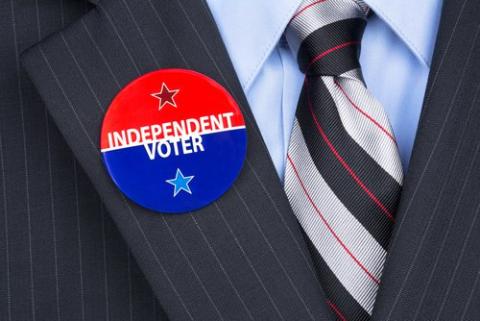Gallup's latest polling found that 49% of Americans self-identify as independent of the two major parties. The record-setting number shows voters’ growing dissatisfaction with the US political process and their options.
Notably, Gallup analyst Jeff Jones observed that Gen X and Millennials are bucking a historical trend.
In the past it was not uncommon for young voters to say they were independent and then as they got older, they would settle on a party because the system only gives them two choices. Gen X and Millennials, however, are largely remaining independent.
Jones acknowledged that voters’ responses to the poll can be attributed to “the disillusionment with the political system, U.S. institutions and the two parties, which are seen as ineffectual, too political and too extreme."
Numbers Don’t Lie: Independent Voters Are Not a Myth
Partisan political pundits like to say independent voters are a myth – that in reality a small segment of the voting population does not consistently vote for one party or the other each election cycle. But these ideas confuse “swing voters” with “independent voters.”
A swing voter’s voting history may show that they voted for the candidate of one party in one election and then the candidate of the other major party in the next cycle. This on its own is not an indicator of independent voting – but rather a response to unsatisfactory representation.
It is entirely possible for an independent voter to vote for candidates of the same party each election cycle. Independent voters are not free from ideology, but they are limited in their options come election season.
Many voters cast a ballot with a “lesser of two evils” mindset. Since the system gives them only two viable options – Republican or Democrat – they are likely going to vote against the person who aligns furthest away from their personal ideology.
This can result in a voter picking candidates from the same party each election cycle, even if they do not personally identify as a member of that party.
Simply put, independent voters are willing to acknowledge ideas and information outside their own ideological persuasions. They understand that there is merit to opposing ideas and are open to consider their own perspective when new information is presented.
This is a far greater indicator of an independent voter than voting record. Another indicator: Deep dissatisfaction with the manufactured two-party system.
It isn’t a coincidence that one historic election cycle for nonpartisan electoral reform after another has consistently occurred over the last decade as more and more Americans choose to identify as independent of the private parties that run every facet of the electoral process.
Primary reform, gerrymandering reform, campaign finance reform, voting reform have become major priorities for American voters. The system isn’t working for them. It has zero competition and zero accountability, and they are fed up.
Gallup polling that shows half of Americans self-identify as independent pushes nonpartisan reform momentum even further, and though partisan pundits and party leaders will not admit it on TV, they understand the threat to the status quo that benefits them.
Pundits, candidates, and officials loyal to their party will continue to say independent voters are a myth, while taking every step possible to hinder any nonpartisan reform they see as a threat to their hold on power.
Look at continued partisan gerrymandering tactics. Look at new bans on voting reforms like ranked choice voting. Look at efforts to close primaries or stop efforts to open them in states across the country.
If this was a Star Wars film, nonpartisan reformers would be experiencing their Empire Strikes Back moment right now. But the key to effecting change is persistence, and with half the country identifying as independent, reformers know there continues to be strong demand and hope for change.
